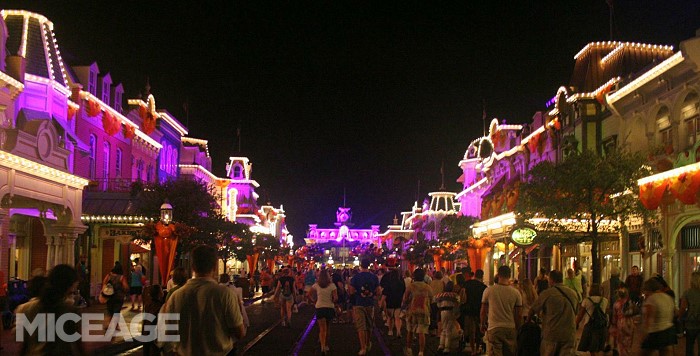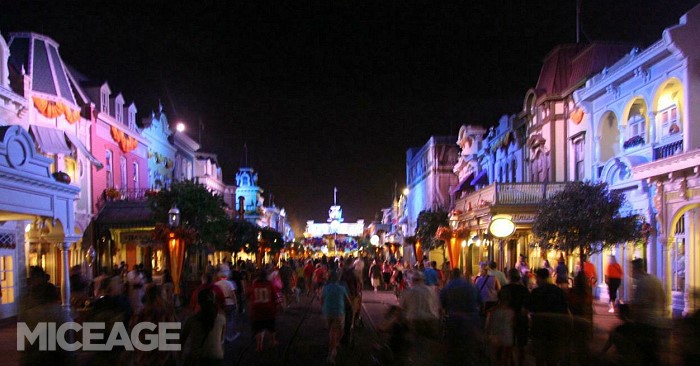Let’s get one thing straight from the outset: I love the Universal parks here in Orlando, and I’m one of the biggest fans of Knott’s Berry Farm in California, but I’m not a shock-shaker-startle kind of guy. I had been to Knott’s Halloween Haunt several times as a teenager and never found it to my liking. I similarly don’t really like horror movies that opt for loud and sudden noises to startle.
|
|
 |
So as a result, I don’t frequent Halloween Horror Nights here at Universal Orlando, and I don’t have a comparison to offer you between Uni and Disney. What I can do, though, is put Disney and SeaWorld side by side. Mickey’s Not So Scary Halloween Party and SeaWorld’s Spooktacular are, on the surface of things, close rivals. Both of them can reasonably be considered the anti-Universal. While HHN is in your face, scary, and done in the same vein as Knott’s Haunt (or similar events we saw at Busch Gardens Williamsburg), the Disney and SeaWorld versions are meant for younger children. Both are gentle, feature characters and photo opportunities, and highlight trick or treating over scary “mazes” (really labyrinths with no dead ends, if memory serves). But you’d be wrong to lump them all the way together. There are some big differences, and none is bigger than the price tag: $60 for the Disney party, while the SeaWorld one is free.

Spooktacular: weird characters, but it’s free!
As you’ve surely guessed by now, that last sentence means all the Halloween festivities, decorations, character meets and photo opportunities, and especially trick or treating is included with the cost of your regular SeaWorld admission ($79). But the way I’ve phrased it doesn’t really capture the whole story. On the one hand, it’s correct to point out that you must buy a special park admission for the Disney party – it’s only open to you in the late afternoon and evening. So it’s not all the way wrong to say that you pay for the Disney one while the SeaWorld one is included, and free with your daytime admission.
But it could be misleading to leave it at that. The Disney party lets you enter at 4pm, and you can stay until park closing at midnight. That’s a full eight hours for your $60. You could reasonably argue that SeaWorld would cost you $79 for all day (a recent Sunday was 9am-8pm; just 11 hours). That’s $7.50 per hour at Disney and $7.11 per hour at SeaWorld – very comparable.

A wedding carriage was seen in 2007 (but I couldn’t find it this year).
Even that’s not the end of the comparison. Both parks have their rides and shows open—you get to enjoy the parks as they normally are. The Magic Kingdom undoubtedly has more to see and do than SeaWorld. And the Magic Kingdom goes ALL OUT for the event. They add themed lighting and they trot out characters, two things SeaWorld tries to do, but cannot match Disney for scale and scope.
And to really cement Disney’s position at the top, I have two words for you: “parade” and “fireworks.” SeaWorld has neither. Disney’s Boo to You parade has one of the most catchy songs I’ve ever heard in a theme park, and it’s phenomenal all around. The gravediggers alone with their showery sparks from shovels dragging on the ground is worth the whole parade. And let’s not forget the thunderous ride of the Headless Horseman before it begins! As if we even needed the icing on the cake, you’ve got HalloWishes, and nobody does fireworks extravaganzas like Disney. Whew. That list is so long I hardly need to mention the dance floors and special shows like the villains one at the castle stage.

Are you hearing Wagner’s “Ride of the Valkyries” in your head?
And yet. Still I sense there is something “off” in this comparison. What’s missing is an analysis of the party timings. Disney may be open for eight hours, but the party itself starts at 7pm—before that it’s just “regular park.” And if you are there for small kids, they are likely to be tired and ready for bed by 9pm. That’s barely two hours. This may sound like nit-picking, but remember that this is the anti-Universal party, so it’s MEANT to draw small kids.
So if we add back in the non-party hours of 4pm-7pm, we’ve got five hours for many visitors to the Disney party. That’s now $12/hour, significantly more than SeaWorld’s $7.11. The SeaWorld operating hours are more in line with small kids to begin with.

An unrelated photo: SeaWorld welcomed a new baby orca on Saturday evening
(seen here on Sunday evening).
Still, despite the higher cost, Disney’s event is clearly the one to beat. The atmosphere is so much more festive, and those parade/fireworks options really do smash the competition. Yet it is here, on the “margin” of the analysis, where I find the most interesting tidbit of all: Disney’s event has become less and less of a value over the years. They’ve removed services, raised prices, and reduced decorations… three actions that all move AGAINST value for the customer. Disney’s still the one to beat, but the margin of their victory is becoming extremely slim.
Look at a simple comparison of Disney’s event, 2005 vs 2010. In 2005, you got the same event that you get today: fireworks, parade, stage show, character meets, dance floors, and trick or treating (in fact one additional candy station). But it cost $42 back then rather than $60 per adult (looking at advance sales, it was $37 in 2005 vs. $54 now). That made it a much better value - $5.25 per hour.

Ghost Mickey in 2005
But wait, there’s more back in 2005. There was a great Ghost Mickey decoration that I couldn’t find in 2010. When you left for the night five years ago, they handed you an oversized chocolate bar (now you get nothing). And while today’s Halloween party offers you 40% off Photopass pictures, back in 2005 you got a completely free family photo, printed out and handed to you to take home.
If you put it like this, the 2010 version of the party is starting to look a little paltry compared to 2005. It’s more expensive, you get less out of it, and – here’s the worst part – it’s starting to lose its amazing decorations. They still put up colored lighting in some key parts (such as the Toontown sign or Space Mountain exterior), but there are fewer zones decorated by such. Frontierland used to be a visual candyland, as was Adventureland. Not now. This year, there was just the usual evening lights on these pathways, with maybe an extra white floodlight or two from the rooftops.

Lights in 2007 (see the green lanterns?) It looks nowhere near this festive in 2010.
Previously, they had switched out the street lamps in Liberty Square for green bulbs. It lent an unreal, certainly phantasmagoric feeling to the area. Alas, in 2010 the street lights are just white.
On Main Street, there used to be so many color spotlights that the buildings took on almost a different character. This year, a few were still there, but they looked more pale, and far less exciting. This sounds like a little thing, but remember that it’s the magical atmosphere more than anything else which made the party feel special.

Main Street in 2007…

… vs Main Street in 2010.
On top of all these ways that Disney World’s party was declining, at the same time SeaWorld’s was getting better and better. I had last gone during this season a few years ago, and my memory of it was that there were few candy stations and only a few decorations. The reality this year was more plentiful. There are 13 candy stations (this is more than Disney has now), and they were distributing brand-name candy: ring pops, Twizzlers, Airheads, Nerds, and M&Ms. Disney, on the other hand, included lesser-known candy (Necco wafers, candy corn) and only occasionally had brand name candy like Smarties, Bit O Honey, and Clark chocolate bars.
So, I say it again: SeaWorld is catching up. Disney is still leading, but if they aren’t careful, they may in fact slip to runner-up when it comes to value. It’s almost inconceivable to me to think of Disney as the lesser draw in anything having to do with the theme parks, but that’s starting to be true in some small ways (Potter for example, and perhaps future versions of these Halloween parties).
Hey Disney, step it up. You’re running out of time. A customer finding a better value somewhere else is not likely to return any time soon—surely the Harvard Business School case studies have drilled this into you. In other words, you don’t get a do-over, certainly not with everybody in your target audience. |
